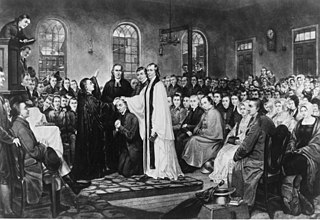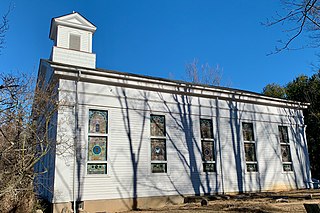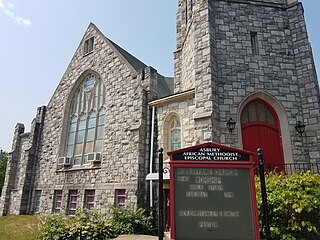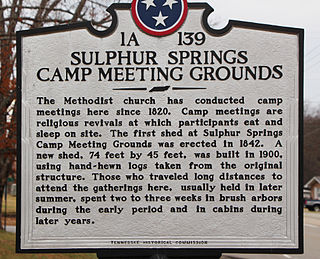Methodism, also called the Methodist movement, is a Protestant Christian tradition whose origins, doctrine and practice derive from the life and teachings of John Wesley. George Whitefield and John's brother Charles Wesley were also significant early leaders in the movement. They were named Methodists for "the methodical way in which they carried out their Christian faith". Methodism originated as a revival movement within Anglicanism originating out of the Church of England in the 18th century and became a separate denomination after Wesley's death. The movement spread throughout the British Empire, the United States and beyond because of vigorous missionary work, and today has about 80 million adherents worldwide.

Francis Asbury was a British-American Methodist minister who became one of the first two bishops of the Methodist Episcopal Church in the United States. During his 45 years in the colonies and the newly independent United States, he devoted his life to ministry, traveling on horseback and by carriage thousands of miles to those living on the frontier.
The Methodist Episcopal Church (MEC) was the oldest and largest Methodist denomination in the United States from its founding in 1784 until 1939. It was also the first religious denomination in the US to organize itself nationally. In 1939, the MEC reunited with two breakaway Methodist denominations to form the Methodist Church. In 1968, the Methodist Church merged with the Evangelical United Brethren Church to form the United Methodist Church.
Albert Cook Outler was a 20th-century American Methodist historian, theologian, and pastor. He was a professor at Duke University, Yale University, and Southern Methodist University. He was a key figure in the 20th-century ecumenical movement.

Georgia Elma Harkness (1891–1974) was an American Methodist theologian and philosopher. Harkness has been described as one of the first significant American female theologians and was important in the movement to legalize the ordination of women in American Methodism.

Nathan Bangs was an American Christian theologian in the Methodist tradition and influential leader in the Methodist Episcopal Church prior to the 1860s.

The Christmas Conference was an historic founding conference of the newly independent Methodists within the United States held just after the American Revolution at Lovely Lane Chapel in Baltimore, Maryland, in 1784.
John Dickins (1746—1798) was an early Methodist preacher in the United States. Born in London in 1746 and educated at Eton College, he came to America and was appointed a Methodist preacher in 1774. He served circuits in Virginia and North Carolina, then went to New York in 1784. He was one of the founding members of the Methodist Episcopal Church at the Christmas Conference in Baltimore in 1784. He had been one of the greeters of Thomas Coke who had arrived as Wesley's emissary to the new American Church.

William Alfred Quayle was an American Bishop of the Methodist Episcopal Church, elected in 1908.

Frederick Bohn Fisher was an American bishop of the Methodist Episcopal Church, elected in 1920. He also gained notability as a pastor, missionary, author, and official in the Methodist missionary and men's movements. He is also one of the founders of the prestigious Mount Hermon School, Darjeeling. The yellow house in Mount Hermon School is named after him as Fisher House.

St. George's United Methodist Church, located at the corner of 4th and New Streets, in the Old City neighborhood of Philadelphia, is the oldest Methodist church in continuous use in the United States, beginning in 1769. The congregation was founded in 1767, meeting initially in a sail loft on Dock Street, and in 1769 it purchased the shell of a building which had been erected in 1763 by a German Reformed congregation. At this time, Methodists had not yet broken away from the Anglican Church and the Methodist Episcopal Church was not founded until 1784.
Abingdon Press is the book publishing arm of the United Methodist Publishing House which publishes sheet music, ministerial resources, Bible-study aids, and other items, often with a focus on Methodism and Methodists.
Cokesbury is an unincorporated community located in the Buckhorn Township of Harnett County, North Carolina, United States. It is a part of the Dunn Micropolitan Area, which is also a part of the greater Raleigh–Durham–Cary Combined Statistical Area (CSA) as defined by the United States Census Bureau.
The Wesley Study Bible is a Methodist-oriented biblical study text with introductory text for each book, explanations and commentary 'to help the reader to understand the biblical text', and with 'special references to the writings of John Wesley'.
Cokesbury College was a college in Abingdon, Maryland, and later Baltimore, Maryland, that existed from 1787 until 1796.
Elmer Talmadge Clark was an American writer, editor and denominational executive for the Methodist Church and supporting groups related to the Methodist Church. Most of his writings are interpretative of the religion and promotional booklets.

Cokesbury, historically known as Cokesburg, is an unincorporated community located on the border of Clinton and Tewksbury townships in Hunterdon County, New Jersey. It was named after two Methodist bishops, Coke and Asbury. The Cokesbury Historic District was listed on the state and national registers of historic places in 1997.

The history of Methodism in the United States dates back to the mid-18th century with the ministries of early Methodist preachers such as Laurence Coughlan and Robert Strawbridge. Following the American Revolution most of the Anglican clergy who had been in America came back to England. John Wesley, the founder of Methodism, sent Thomas Coke to America where he and Francis Asbury founded the Methodist Episcopal Church, which was to later establish itself as the largest denomination in America during the 19th century.

Asbury AME Church is an African Methodist Episcopal Church founded in 1845 in Chester, Delaware County, Pennsylvania, United States. It is the second African Methodist Episcopal church founded in Chester behind the Union African Methodist Church in 1832. Asbury AME Church is located at 1712 Providence Avenue and is an active worship center.

A brush arbour revival, also known as brush arbour meeting, is a revival service that takes place under an open-sided shelter called an "arbour", which is "constructed of vertical poles driven into the ground with additional long poles laid across the top as support for a roof of brush, cut branches or hay".










